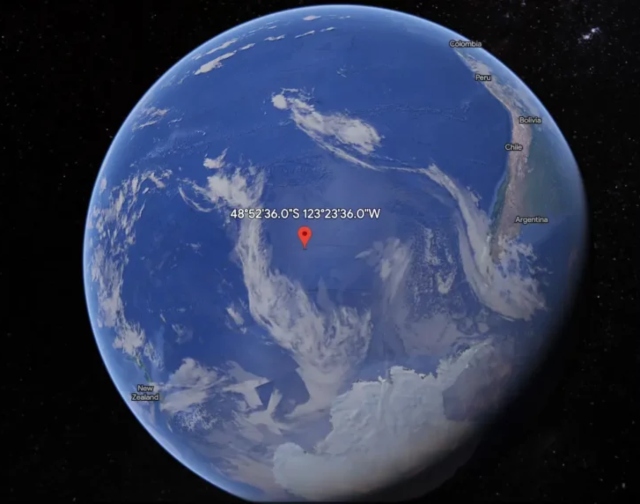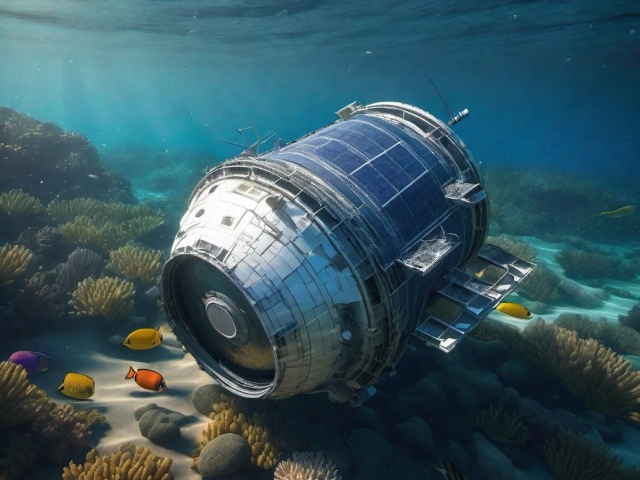
-
Point Nemo – The Most Remote Place On Earth Where Spacecrafts Are Laid To Rest [Video]
01 Feb 2024 by Heinrich in Tech/Sci, Video, World
[imagesource:wonderai]
Called the loneliest place on earth, Point Nemo is nothing but a cluster of tiny islands, yet its geographical location has made it the perfect place to dump satellites and other space junk that crash back to Earth.
Sitting in the middle of the Pacific Ocean, the ‘space graveyard’ is also known as the ‘pole of inaccessibility’, with the nearest patch of land 2,700 kilometres away.
It’s so remote, that the nearest people to it are the crew of the International Space Station as they pass over the area at an altitude of 400 kilometres twice a day.
This remote location has made it the perfect place to aim for when we decommission (crash) old spacecraft, and the ocean floor around this area is littered with debris from outside our planet. At 4,000 metres deep, the ocean around these parts is a perfect place for a graveyard.
Since the 1970s, space programmes have dumped about 300 craft, including space stations and satellites, into the ocean at Point Nemo. NASA also revealed that it will do the same with the International Space Station (ISS), which has been in space for 25 years and will be officially decommissioned in 2031. It will be the largest object to be ‘buried’ in the space graveyard.
Dropping spaceships into the drink might sound like a bad idea, but the alternative is to leave it in orbit along with the estimated 4,000 other abandoned pieces of junk floating around above our heads. The ‘space junk’ issue has become so big that plenty of scientists think it might become a hindrance to agencies travelling to space in the near future.
[image:starlust.org]
Point Nemo is just so remote that dropping a few tons from space into this area holds virtually no danger of hitting anything living. Even the ocean here seems to be a willing recipient.
The ocean around Point Nemo is relatively devoid of life with weak ocean currents in the region and the remoteness from land limiting the flow of nutrients, resulting in a ‘strikingly little biodiversity’. Bernhard Fuchs, from the Max Planck Institute for Marine Microbiology, studied the region in 2019, and found “probably the lowest cell numbers ever measured in oceanic surface waters.”
Ironically, this makes its water some of the clearest in the world due to the low biomass count.
Point Nemo doesn’t sound like a perfect place to ‘escape the city’, and once you do cross the 2,700 kilometres of open ocean, you still have to cross another 2,700 kilometres to get back. If a satellite doesn’t crash down on your boat first.
[source:sciencealert]
Latest News
-
Game, Seth, Match – Goodbye 2024
Hey Guys - thought I’d just give a quick reach-around and say a big thank you to our rea...
-
Breakfast Of Champions: Hollywoodbets Kenilworth Racecourse Breakfast Gallops Is Back!
[imagesource:CapeRacing] For a unique breakfast experience combining the thrill of hors...
-
Need NYE Plans? Cafe Caprice’s Night Of Enchantment Masquerade Party Could Do The Trick
[imagesource:howler] If you're still stumped about what to do to ring in the new year -...
-
Buckingham Palace Steps In After Staff Christmas Party Spirals Out Of Control
[imagesource:maxandeli/facebook] It's not just in corporate that staff parties get a li...
-
Designer Babies Are Running Into Trouble As Teens, Grappling With Being ‘Experiments’
[imagesource:here] Imagine being born with the weight of your parents’ version of per...
-






























